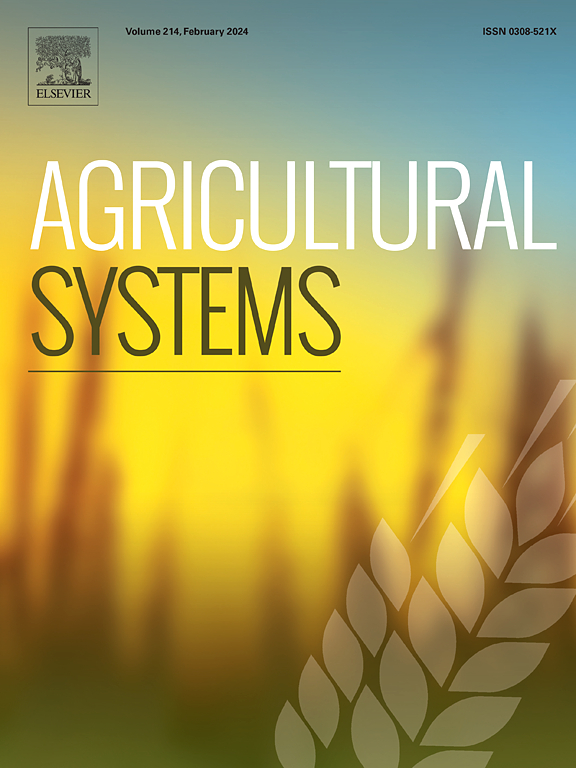预测气候变化下的阿拉比卡咖啡产量趋势:基于过程的大陆尺度建模研究
IF 6.1
1区 农林科学
Q1 AGRICULTURE, MULTIDISCIPLINARY
引用次数: 0
摘要
气候变化可能会对咖啡生产产生负面影响,例如产量下降。要解决这一问题,就需要确定气候风险,并评估跨空间和环境梯度的农艺实践的适应潜力。目的通过模拟咖啡生长、气候因素和农艺管理之间的生理联系,评估气候变化对大陆尺度阿拉比卡咖啡产量的影响,并评估农林业环境下增加遮荫树密度的具体适应措施。方法在评估了基于过程的模型DynACof在模拟阿拉比卡咖啡产量方面的表现(使用先前研究的数据)之后,我们开发了一个名为G-DynACof的新工具,这是一个利用广泛的气候预测和土壤地理数据在区域尺度上对DynACof进行空间化的建模框架。我们使用G-DynACof模拟了拉丁美洲和非洲的潜在咖啡产量趋势,使用了2036-2065年期间与1985-2014年历史时期相比的缩小规模和偏差校正的气候预测。尽管由于缺乏区域尺度的农艺管理信息而存在相当大的不确定性,但我们的研究结果表明,根据所考虑的共享社会经济途径(SSP)(分别为SSP1-2.6和SSP5-8.5),拉丁美洲的潜在产量可能下降23%至35%,非洲可能下降16%至21%。产量变化在空间上具有很大的异质性,在高海拔和低纬度地区产量增加,表明未来可能发生产区转移。在我们的模拟中,遮荫树密度增加对生产力的影响也存在空间差异,其适应气候变化的潜力仍然不确定,需要进一步研究。咖啡农业系统的影响分析和适应建模,加上社会经济指标,可以描绘现实、全面、综合的风险评估,并支持有效的适应建议。本文章由计算机程序翻译,如有差异,请以英文原文为准。

Projecting trends of arabica coffee yield under climate change: A process-based modelling study at continental scale
CONTEXT
Climate change may lead to negative impacts on coffee production, such as reduced yields. Addressing this issue requires identifying climate risks and assessing the adaptation potential of agronomic practices across spatial and environmental gradients.
OBJECTIVE
This study aimed to evaluate climate change impacts on arabica coffee yields at continental scale and evaluate a specific adaptation measure, i.e. increasing shade tree density in agroforestry settings, by simulating the physiological links between coffee growth, climatic factors and agronomic management.
METHODS
After evaluating the performance of the process-based model DynACof in simulating arabica yields (using data from previous studies), we developed a new tool called G-DynACof, a modelling framework for spatializing DynACof on a regional scale using extensive climate projections and soil geodata. We used G-DynACof to simulate trends of potential coffee yields in Latin America and Africa using an ensemble of downscaled and bias-corrected climate projections for the period 2036–2065 compared to a historical period 1985–2014.
RESULTS AND CONCLUSIONS
Despite considerable uncertainties due to the scarcity of information on agronomic management at the regional scale, our results indicate that potential yields could decrease between 23 % and 35 % in Latin America and between 16 % and 21 % in Africa, depending on the Shared Socioeconomic Pathway (SSP) considered (SSP1–2.6 and SSP5–8.5, respectively). Yield variations were very heterogeneous in space, with yields increasing at high altitudes and low latitudes, indicating a possible future shift of production areas. In our simulations, the effect of increased shade tree density on productivity was also spatially variable, and its potential for adaptation to climate change remains uncertain, requiring further investigation.
SIGNIFICANCE
Impact analyses and adaptation modelling of coffee agrosystems, together with socio-economic indicators, can delineate realistic, comprehensive, integrated risk assessments and support effective adaptation recommendations.
求助全文
通过发布文献求助,成功后即可免费获取论文全文。
去求助
来源期刊

Agricultural Systems
农林科学-农业综合
CiteScore
13.30
自引率
7.60%
发文量
174
审稿时长
30 days
期刊介绍:
Agricultural Systems is an international journal that deals with interactions - among the components of agricultural systems, among hierarchical levels of agricultural systems, between agricultural and other land use systems, and between agricultural systems and their natural, social and economic environments.
The scope includes the development and application of systems analysis methodologies in the following areas:
Systems approaches in the sustainable intensification of agriculture; pathways for sustainable intensification; crop-livestock integration; farm-level resource allocation; quantification of benefits and trade-offs at farm to landscape levels; integrative, participatory and dynamic modelling approaches for qualitative and quantitative assessments of agricultural systems and decision making;
The interactions between agricultural and non-agricultural landscapes; the multiple services of agricultural systems; food security and the environment;
Global change and adaptation science; transformational adaptations as driven by changes in climate, policy, values and attitudes influencing the design of farming systems;
Development and application of farming systems design tools and methods for impact, scenario and case study analysis; managing the complexities of dynamic agricultural systems; innovation systems and multi stakeholder arrangements that support or promote change and (or) inform policy decisions.
 求助内容:
求助内容: 应助结果提醒方式:
应助结果提醒方式:


